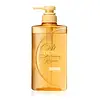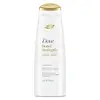What's inside
What's inside
 Key Ingredients
Key Ingredients

 Benefits
Benefits

 Concerns
Concerns

 Ingredients Side-by-side
Ingredients Side-by-side

Water
Skin ConditioningIsopentyldiol
HumectantStearyl Alcohol
EmollientBehentrimonium Chloride
PreservativeGlycerin
HumectantDimethicone
EmollientCetearyl Alcohol
EmollientBehenyl Alcohol
EmollientAminopropyl Dimethicone
Hydrogenated Polyisobutene
EmollientSteartrimonium Chloride
PreservativePolysilicone-13
Camellia Seed Oil
Lactic Acid
BufferingLysine Lauroyl Glutamate
CleansingSqualane
EmollientRoyal Jelly Extract
Skin ConditioningGlycine Max Seed Extract
Skin ConditioningIsopropyl Alcohol
SolventDipropylene Glycol
HumectantIsopropyl Myristate
EmollientPEG-2 Laurate
EmulsifyingSalicylic Acid
MaskingAmodimethicone
PPG-2-Deceth-12
EmulsifyingMethylserine
Skin ConditioningDisodium EDTA
Cetrimonium Chloride
AntimicrobialButylene Glycol
HumectantTocopherol
AntioxidantSodium Benzoate
MaskingPhenoxyethanol
PreservativeParfum
MaskingCI 17200
Cosmetic ColorantCI 15985
Cosmetic ColorantWater, Isopentyldiol, Stearyl Alcohol, Behentrimonium Chloride, Glycerin, Dimethicone, Cetearyl Alcohol, Behenyl Alcohol, Aminopropyl Dimethicone, Hydrogenated Polyisobutene, Steartrimonium Chloride, Polysilicone-13, Camellia Seed Oil, Lactic Acid, Lysine Lauroyl Glutamate, Squalane, Royal Jelly Extract, Glycine Max Seed Extract, Isopropyl Alcohol, Dipropylene Glycol, Isopropyl Myristate, PEG-2 Laurate, Salicylic Acid, Amodimethicone, PPG-2-Deceth-12, Methylserine, Disodium EDTA, Cetrimonium Chloride, Butylene Glycol, Tocopherol, Sodium Benzoate, Phenoxyethanol, Parfum, CI 17200, CI 15985
Water
Skin ConditioningSodium C12-13 Pareth Sulfate
CleansingCocamidopropyl Betaine
CleansingSodium Gluconate
Skin ConditioningCocos Nucifera Oil
MaskingSh-Polypeptide-121
Skin ConditioningHydrolyzed Pea Protein
EmollientHydrolyzed Vegetable Protein
Skin ConditioningHydrolyzed Soy Protein
HumectantParfum
MaskingDimethiconol
EmollientSodium Chloride
MaskingCitric Acid
BufferingGlycerin
HumectantGlycol Distearate
EmollientCarbomer
Emulsion StabilisingSodium Benzoate
MaskingSodium Laureth Sulfate
CleansingGuar Hydroxypropyltrimonium Chloride
Skin ConditioningPPG-9
Skin ConditioningTea-Dodecylbenzenesulfonate
CleansingCocamide Mea
EmulsifyingDisodium EDTA
PEG-45m
HumectantBenzyl Salicylate
PerfumingCitronellol
PerfumingHexyl Cinnamal
PerfumingLimonene
PerfumingLinalool
PerfumingMica
Cosmetic ColorantCI 17200
Cosmetic ColorantCI 77891
Cosmetic ColorantCI 19140
Cosmetic ColorantWater, Sodium C12-13 Pareth Sulfate, Cocamidopropyl Betaine, Sodium Gluconate, Cocos Nucifera Oil, Sh-Polypeptide-121, Hydrolyzed Pea Protein, Hydrolyzed Vegetable Protein, Hydrolyzed Soy Protein, Parfum, Dimethiconol, Sodium Chloride, Citric Acid, Glycerin, Glycol Distearate, Carbomer, Sodium Benzoate, Sodium Laureth Sulfate, Guar Hydroxypropyltrimonium Chloride, PPG-9, Tea-Dodecylbenzenesulfonate, Cocamide Mea, Disodium EDTA, PEG-45m, Benzyl Salicylate, Citronellol, Hexyl Cinnamal, Limonene, Linalool, Mica, CI 17200, CI 77891, CI 19140
 Reviews
Reviews

Ingredients Explained
These ingredients are found in both products.
Ingredients higher up in an ingredient list are typically present in a larger amount.
Ci 17200 is a synthetic reddish-purple dye.
Disodium EDTA plays a role in making products more stable by aiding other preservatives.
It is a chelating agent, meaning it neutralizes metal ions that may be found in a product.
Disodium EDTA is a salt of edetic acid and is found to be safe in cosmetic ingredients.
Learn more about Disodium EDTAGlycerin is already naturally found in your skin. It helps moisturize and protect your skin.
A study from 2016 found glycerin to be more effective as a humectant than AHAs and hyaluronic acid.
As a humectant, it helps the skin stay hydrated by pulling moisture to your skin. The low molecular weight of glycerin allows it to pull moisture into the deeper layers of your skin.
Hydrated skin improves your skin barrier; Your skin barrier helps protect against irritants and bacteria.
Glycerin has also been found to have antimicrobial and antiviral properties. Due to these properties, glycerin is often used in wound and burn treatments.
In cosmetics, glycerin is usually derived from plants such as soybean or palm. However, it can also be sourced from animals, such as tallow or animal fat.
This ingredient is organic, colorless, odorless, and non-toxic.
Glycerin is the name for this ingredient in American English. British English uses Glycerol/Glycerine.
Learn more about GlycerinParfum is a catch-all term for an ingredient or more that is used to give a scent to products.
Also called "fragrance", this ingredient can be a blend of hundreds of chemicals or plant oils. This means every product with "fragrance" or "parfum" in the ingredients list is a different mixture.
For instance, Habanolide is a proprietary trade name for a specific aroma chemical. When used as a fragrance ingredient in cosmetics, most aroma chemicals fall under the broad labeling category of “FRAGRANCE” or “PARFUM” according to EU and US regulations.
The term 'parfum' or 'fragrance' is not regulated in many countries. In many cases, it is up to the brand to define this term.
For instance, many brands choose to label themselves as "fragrance-free" because they are not using synthetic fragrances. However, their products may still contain ingredients such as essential oils that are considered a fragrance by INCI standards.
One example is Calendula flower extract. Calendula is an essential oil that still imparts a scent or 'fragrance'.
Depending on the blend, the ingredients in the mixture can cause allergies and sensitivities on the skin. Some ingredients that are known EU allergens include linalool and citronellol.
Parfum can also be used to mask or cover an unpleasant scent.
The bottom line is: not all fragrances/parfum/ingredients are created equally. If you are worried about fragrances, we recommend taking a closer look at an ingredient. And of course, we always recommend speaking with a professional.
Learn more about ParfumSodium Benzoate is a preservative. It's used in both cosmetic and food products to inhibit the growth of mold and bacteria. It is typically produced synthetically.
Both the US FDA and EU Health Committee have approved the use of sodium benzoate. In the US, levels of 0.1% (of the total product) are allowed.
Sodium benzoate works as a preservative by inhibiting the growth of bacteria inside of cells. It prevents the cell from fermenting a type of sugar using an enzyme called phosphofructokinase.
It is the salt of benzoic acid. Foods containing sodium benzoate include soda, salad dressings, condiments, fruit juices, wines, and snack foods.
Studies for using ascorbic acid and sodium benzoate in cosmetics are lacking, especially in skincare routines with multiple steps.
We always recommend speaking with a professional, such as a dermatologist, if you have any concerns.
Learn more about Sodium BenzoateWater. It's the most common cosmetic ingredient of all. You'll usually see it at the top of ingredient lists, meaning that it makes up the largest part of the product.
So why is it so popular? Water most often acts as a solvent - this means that it helps dissolve other ingredients into the formulation.
You'll also recognize water as that liquid we all need to stay alive. If you see this, drink a glass of water. Stay hydrated!
Learn more about Water